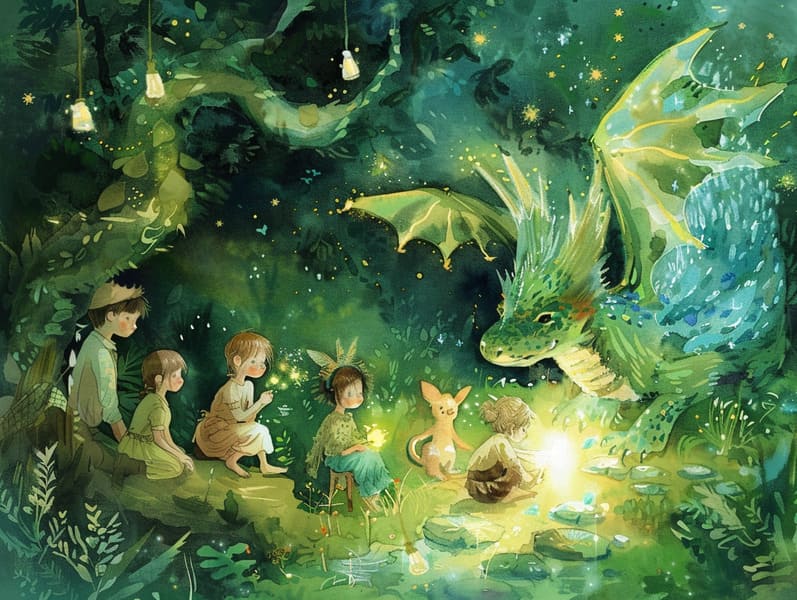The Emergence of Best Fairy Tales with Its Undying Appeal.
The Emergence of Best Fairy Tales with Its Undying Appeal.
Blog Article

Traditional fairy tales have enduring presence. These tales have been transmitted from one generation to the next far before they were ever published. They arose from a variety of civilizations, including Indigenous traditions. They were initially transmitted among mature audiences, often carrying themes and messages concerning the societal norms and beliefs of the time.
The Grimm brothers, Jacob and Wilhelm (the Grimm brothers), were among the first to gather and publish many of these beloved narratives. Their volume, "Grimm's Story Collection," included tales like "The Story of Cinderella," "The Story of Hansel and Gretel," and "Snow White," which have since become cornerstones in the world of classic fairy tales. Similarly, Hans Christian Andersen's magical narratives, such as "The Mermaid," and "The Story of the Ugly Duckling," have touched hearts worldwide, establishing their place in the pantheon of classic fairy tales.
Even though they are old, these tales remain as impactful as ever, especially as nighttime stories for kids. These magical stories are now available in different formats, including richly illustrated books, whimsical animations, and digital storybooks.
Their continued relevance can be ascribed to several enchanting factors:
Crucial Morals: Old fairy tales often share important moral lessons. Stories like "The Boy Who Cried Wolf" teach the virtue of truth, while "The Tortoise and the Hare" point out the traits of tenacity and unassuming nature. These tales offer kids clear distinctions between good and bad, molding their moral compass in a subtle yet deep way.
Sympathy and Perception: Ancient fairy tales frequently portray personalities facing obstacles and hardships, encouraging listeners to identify with their struggles and champion their triumphs. For instance, "The Tale of Beauty and the Beast" highlights the virtue of seeing beyond looks to perceive the true essence of a soul, advancing insight and recognition.
Cultural Understanding: Many timeless fairy tales are rooted in the cultural contexts from which they developed. Exploring these tales can provide captivating looks into different cultures, cultivating a sense of global appreciation and perception.
Fantasy and Innovation: The fantastical elements in traditional fairy tales—enchanted forests—promote children’s creativity. These tales lead readers to extraordinary realms, enhancing fantasy-filled thoughts and a sense of excitement that remains a lifetime.
Ancient fairy tales are not only charming but also teaching. They act as enchanted tools in promoting various thinking and feeling skills fairy tales in children. When ancient fairy tales are narrated, they promote linguistic abilities by offering new language and detailed sentence structures. This practice also boosts listening abilities and mental focus, as young readers track the narrative, excited to see what happens next.
Furthermore, contemplating the themes and characters of fairy tales can sharpen thinking skills and thought processes. Young readers are led to find patterns, anticipate outcomes, and get cause and effect. These examinations also encourage the young express their thoughts and feelings, strengthening their emotional intelligence.
In today’s high-tech era, the presence of digital storybooks has made these stories more acquirable than ever. Websites and online apps give vast collections of Grimm's fairy tales that can be looked at or listened via anytime, anywhere. Fairy tales voiced are particularly widespread, featuring an charming way for little ones to engage with these delightful tales. Read-aloud stories and voiced videos lead characters and settings to life, often augmented by mesmerizing melodies and harmonies that enrich the narrative experience.
The lasting allure of timeless fairy tales lies in their ability to transform to modern society while holding onto their essential themes. Contemporary reinterpretations of these narratives often spotlight more multicultural figures and modern settings, making them relatable to today’s audience. However, the underlying themes of spirit, generosity, and even-handedness remain unchanged, continuing to connect with audiences of all ages.
Traditional fairy tales also offer a sense of reassurance and familiarity. They present a coherent narrative with a definite beginning, middle, and end, often ending with the closure of conflicts and the triumph of virtue over vice. This dependability can be consoling for young ones, imparting a sense of sturdiness in an unstable world.
Timeless fairy tales continue to entrance and coach new generations, maintaining their splendor and impact in modern society. As children's bedtime stories, they give a perfect blend of fantasy and learning, cultivating moral values, empathy, and creativity. The proliferation of online storybooks and the popularity of fairy tales narrated affirm that these old fairy tales remain within reach to new generations.
By continuing and releasing these narratives, we continue to acknowledge the rich tapestry of cultural legacy and cultural heritage. Whether you are seeing a gorgeously illustrated book, perusing a electronic collection, or listening via an narrated book, the charm of classic fairy tales is always within reach. These stories reveal of the unfading force of narratives and its ability to bring us together across eras and regions.
Be it you are experiencing a vibrantly illustrated book, discovering a cyber collection, or listening via an narrated book, the captivation of old fairy tales is always within reach.
These stories remind us of the immortal spell of stories and its ability to gather us across epochs and places, weaving a spell that charms and informs alike.